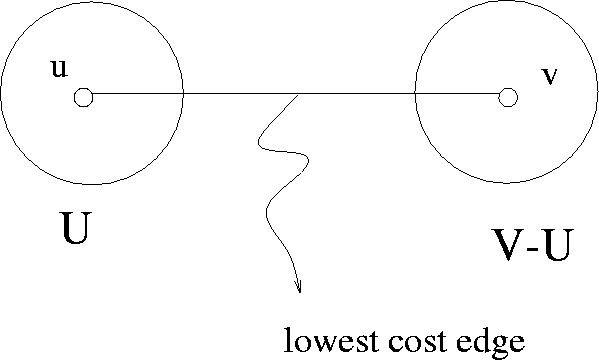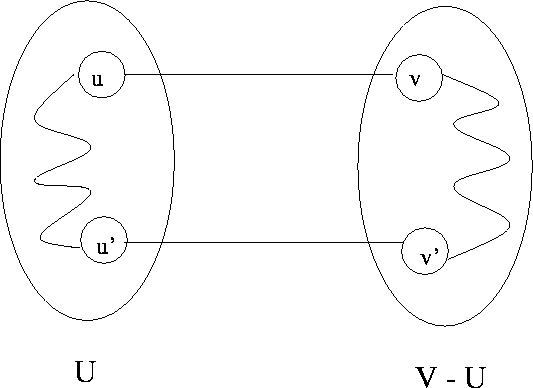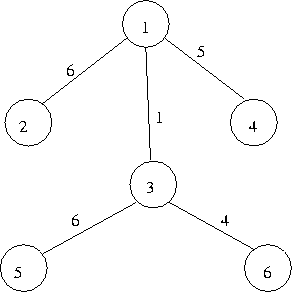If (u, v) is an edge of lowest cost such
that u![]() Uand v
Uand v![]() V
- U, then there exists an MST that includes (u,
v)
as an edge. See Figure 8.5.
V
- U, then there exists an MST that includes (u,
v)
as an edge. See Figure 8.5.
 |
Proof of MST Property
Suppose to the contrary that there is no MST for the graph Gwhich includes the edge (u, v).
Let T be any MST of G. By
our assumption, T does not contain (u,
v).
Adding (u, v) to Twill introduce
a cycle since T is a free tree. This cycle involves (u,
v). Therefore there is a path fromv to u
that does not pass through this edge. This means that![]() another
edge (u', v') in T such that
u'
another
edge (u', v') in T such that
u'![]() Uandv'
Uandv'![]() V
- U. See Figure 8.6.
V
- U. See Figure 8.6.
 |
Deleting edge (u', v') breaks the cycle and yields a spanning
tree
T' whose cost is certainly ![]() that of T since C(u, v)
that of T since C(u, v) ![]() C(u',
v'). Thus we have constructed an MST that includes (u, v).
C(u',
v'). Thus we have constructed an MST that includes (u, v).
 |
To illustrate, consider the graph in Figure 8.7 and refer to Figures 8.8 and 8.9. Consider the sets:
| U | = | {1, 2, 5} | |
| V - U | = | {3, 4, 6}. |
 |
Spanning tree with cost = 26. Now, least cost edge from U to V - U is (1,3).
By including (1,3) in the above spanning tree, a cycle will form (for
example, 1-2-3-1). Let us replace the edge (2,3) by the edge (1,3).
 |
This has yielded a ST with cost = 22
MST Lemma: Let
 |
Proof
Since T is promising, it can be extended to obtain an MST, says S. If e![]() S, there is nothing to prove.
S, there is nothing to prove.
If e![]() S, then we add edge e to S, we create exactly one cycle (since S is
a spanning tree). In this cycle, since e leaves U there exists at least
one other edge, f say, that also leaves U (otherwise the cycle could
not close). See Figure 8.10.
S, then we add edge e to S, we create exactly one cycle (since S is
a spanning tree). In this cycle, since e leaves U there exists at least
one other edge, f say, that also leaves U (otherwise the cycle could
not close). See Figure 8.10.
If we now remove f, the cycle disappears and we obtain a new tree R that spans G.
Note thatR = (S![]() {e}) - {f}
{e}) - {f}
Also note that weight of e![]() weight
of f since e is a least cost edge leaving U.
weight
of f since e is a least cost edge leaving U.
Therefore R is also an MST and it includes edge e. Furthermore T![]() R and so can be extended to the MST R. Thus T is a promising set of
edges.
R and so can be extended to the MST R. Thus T is a promising set of
edges.